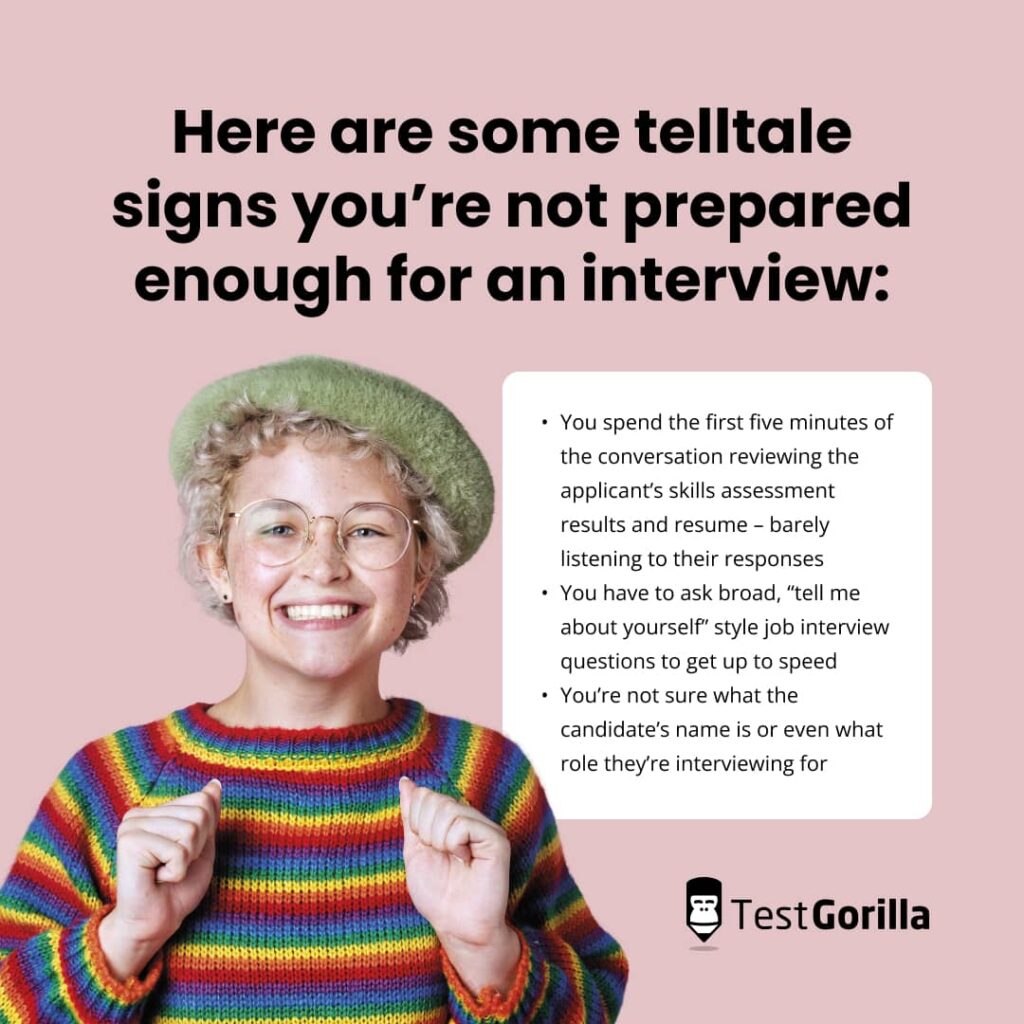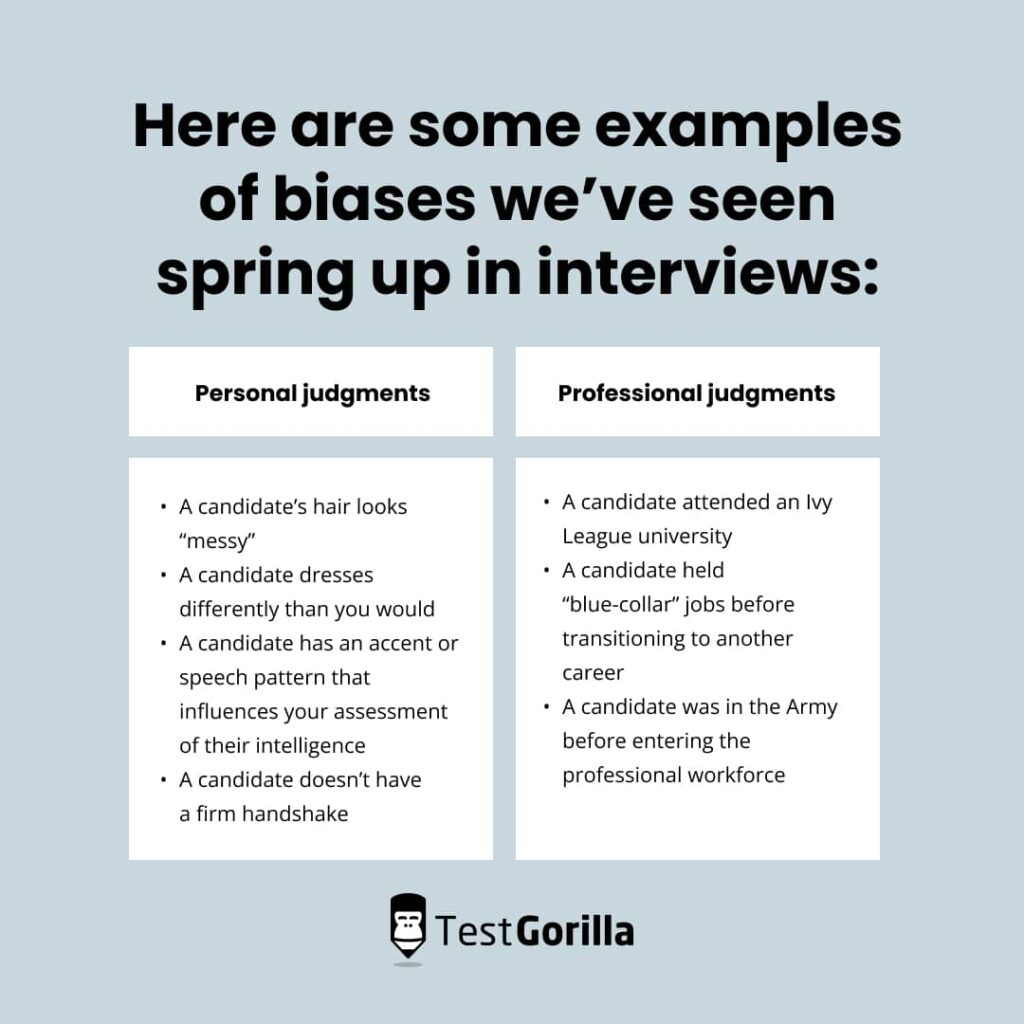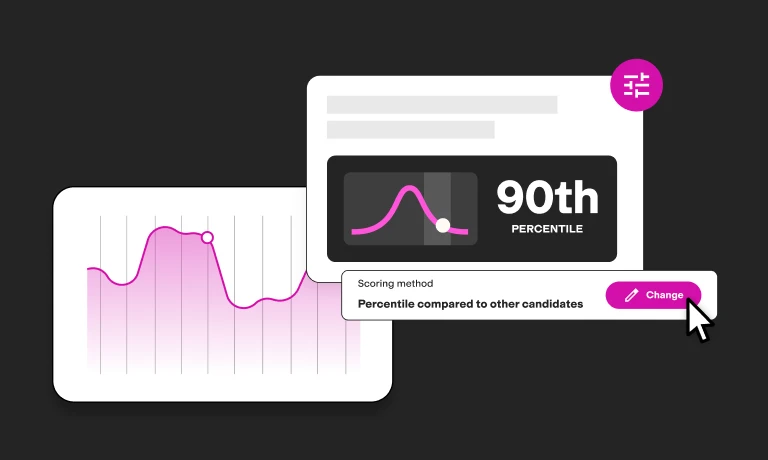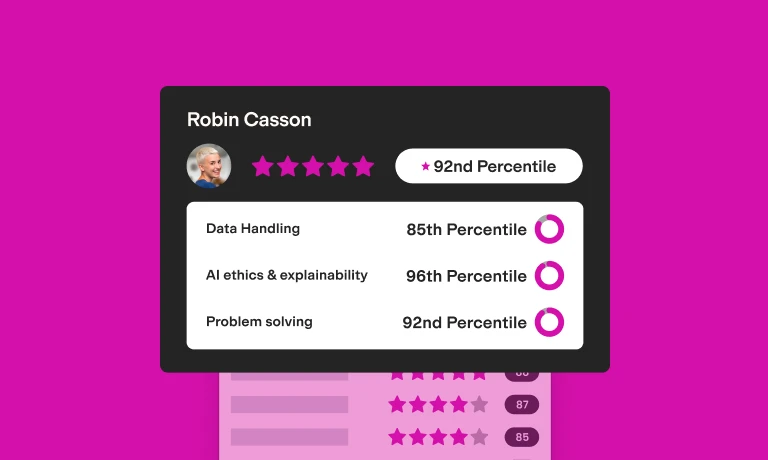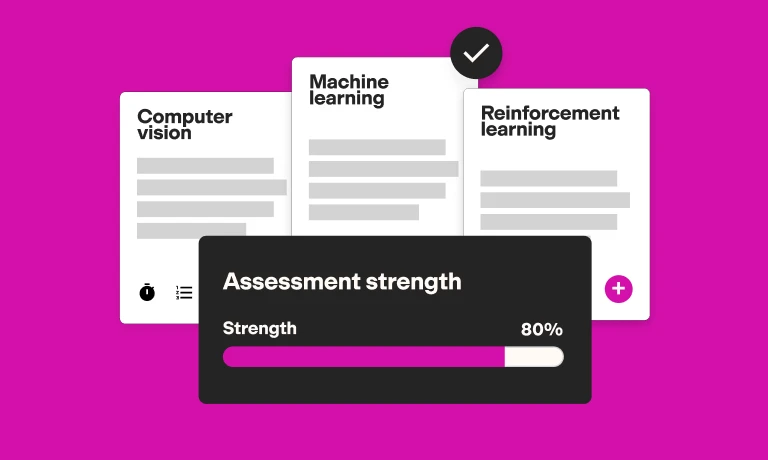11 common interview mistakes you don’t want to make as a hiring manager
Hiring managers have a tough job. Screen a mountain of candidates to find the perfect one, do so quickly, and continue handling day-to-day responsibilities at the same time.
Add in the pressure to avoid mistakes – bad hires cost companies money, time, and reputation – and you have a tall task.
So it’s no surprise businesses rely on interviews to get a better sense of applicants before making hiring decisions. And while we agree that interviews are vital to finding great talent, there are lots of mistakes that can get in the way of this goal.
At TestGorilla, we put our heads together to bring you the most common interview mistakes we see others making, so you can avoid them and hire the best candidates confidently.
Odds are, at least one of these mistakes looks familiar, so go through each carefully and look out for some of our suggested solutions.
11 common mistakes interviewers make (and how to avoid them)
Finding and hiring the right talent for your company is no small effort.
A typical recruiting process takes considerable resources to:
Assess the talent needs within your organization
Pay to list open roles on job boards to source high-quality applicants
Post job openings directly on the company’s website
Process, review, and screen applicants to narrow down the best options
Carve time out of employees’ calendars to interview candidates
Interviews are often the final and most important step to ensure these investments aren’t wasted by filling the position with the right hire, which makes mistakes at this stage extra costly.
Hiring the wrong individual can damage company culture, hamper productivity, and create duplicative costs to rehire and retrain a replacement down the line.
A poor interview process can also turn off the otherwise amazing talent and cause your company to miss out on a candidate it should have hired.
The key to placing applicants that contribute positively from day one is being a good interviewer and avoiding these common pitfalls in the interview process.
Summary
Here’s a quick look at common interview mistakes if you’re strapped for time:
Common interviewing mistakes managers make | Examples of interview mistakes |
1. Not preparing for the interview | Showing up to interview a candidate without knowing their name and barely skimming their resume |
2. Using interviews at the wrong stage in the hiring process | Using interviews as a screening tool too early in the hiring process |
3. Getting too personal with candidates | Asking inappropriately casual questions or addressing topics that are illegal to ask about |
4. Forgetting about cultural fit | Only focusing on hard skills and success measures while caring little about a candidate’s values and behaviors |
5. Making snap judgments | Making hiring decisions based on gut feelings and first impressions in ways that allow bias to creep into the process |
6. Rushing to fill the role | Going with the first mediocre candidate after a long hiring process because the right fit is difficult to find |
7. Not giving a clear job description | Failing to adequately explain the responsibilities and expectations to candidates |
8. Placing too much emphasis on grades and experience | Focusing solely on generic markers of success, like which school a candidate attended or the names of previous employers |
9. Not relying on structured questions | Allowing a process where each interviewer asks different questions and guides the conversation according to their own beliefs |
10. Making the candidate feel uncomfortable | Using brain-teaser or “gotcha” questions to throw the candidate off during their interview process |
11. Overlooking internal talent | Only considering external talent to fill a role and being biased against or blind to the talent that already exists in your organization |
1. Not preparing for the interview
We get it – hiring managers and other interviewers have day jobs to attend to that might seem more important than pre-interview prep.
But not setting aside enough time to prepare for interviews is a recipe for failure.
As the interviewer, you’re unlikely to get the depth of knowledge about the candidate you want without putting in some work beforehand. Plus, the interviewee is likely to recognize the lack of attention and lose interest in your company.
Here are some telltale signs you’re not prepared enough for an interview:
You spend the first five minutes of the conversation reviewing the applicant’s skills assessment results and resume – barely listening to their responses
You have to ask broad, “tell me about yourself” style job interview questions to get up to speed
You’re not sure what the candidate’s name is or even what role they’re interviewing for
We’re not here to shame you, but “winging it” isn’t a great strategy.
The solution? Leverage HR tools that make reviewing all the relevant hiring materials (job description, skills assessments, resume, references) easy to navigate and quick to review.
2. Using interviews at the wrong stage in the hiring process
Interviews are extremely valuable because they provide unique insights into candidates that are difficult to assess without a personal conversation.
In an interview, you can really understand how applicants approach problems and what values they hold.
The problem with interviews is that they’re time-consuming and difficult to scale.
It’s not unusual for a company to require five or more hour-long interviews as part of the hiring process. That’s five hours out of productive employees’ days for every single applicant (not including the time it took HR to get the job seekers this far).
Using interviews too early in the hiring process to vet a candidate’s quality wastes an enormous amount of time.
Instead, the solution is to use other objective methods to determine if job seekers have the right skills before interviewing them.
Pre-employment skills assessments, like those we offer at TestGorilla, provide an accurate way to screen applicants for quality and fit before spending precious company resources to interview them.
3. Getting too personal with candidates
Finding the right balance between being overly professional or closed off and being inappropriately personal can be difficult for interviewers.
After all, you want applicants to feel like they would enjoy working at your company.
But the primary goal of an interview isn’t to get a candidate to like you. It’s to assess whether their skills and talents are a great fit for your business.
Being too chummy is one way to cross personal boundaries, but so is asking questions that are illegal from an HR perspective.
What hiring practices cross the legal line depends on your local laws, but generally, it’s illegal to ask questions about a candidate’s:
Age
Race
Gender
And other protected statuses
The easiest solution is to take any guesswork out of the interview by using structured questions and having clear HR policies that outline the red lines to avoid crossing them.
4. Forgetting about cultural fit
You’ve read the candidate’s resume, prepared insightful questions, and are ready to dig into their experiences and skills.
You’re absolutely on the right track, but in your zeal to pick apart their aptitude, you might forget something equally important: culture fit.
After all, a business is nothing more than a collection of people, and raw intelligence can’t overcome poor teamwork.
What’s more, culture doesn’t just matter to your business. It also matters to 79% of candidates who consider a company’s mission and culture before applying.
That’s why at TestGorilla, we focus on the concept of finding a “culture add.”
These are employees whose values and beliefs align with your organization but add a diverse viewpoint, so your business continues to evolve.
That’s why we suggest incorporating explicit culture questions into your interview process and leveraging cultural assessments on top of skills-based reviews.
5. Making snap judgments
Unfortunately, we see bias creep into the hiring process routinely when companies rely on subjective and personal assessments of candidates.
Snap judgments about an applicant are difficult to overcome when they happen unintentionally or even unconsciously.
Here are some examples of biases we’ve seen spring up in interviews:
Personal judgments | Professional judgments |
A candidate’s hair looks “messy”; A candidate dresses differently than you would; A candidate has an accent or speech pattern that influences your assessment of their intelligence; A candidate doesn’t have a firm handshake | A candidate attended an Ivy League university; A candidate held “blue-collar” jobs before transitioning to another career; A candidate was in the Army before entering the professional workforce |
The problem is that these subjective judgments have little to nothing to do with an applicant’s talents or ability to contribute successfully to your organization.
The solution is to reduce bias in the hiring process and use more quantitative measures of success.
For example, our skills assessments use statistical analysis and employer feedback to predict success objectively. Businesses can easily compare results across candidates to locate the best applicants.
6. Rushing to fill the role
Hiring fatigue is real.
It can be hard to sift through applicant after applicant and still not find the right fit.
But that’s to be expected when you likely need to interview up to 10 candidates to fill just one role.[1]
Hiring a candidate that’s adequate but not “perfect” might seem harmless, but when you consider the potential downsides, it can be a costly mistake.
The wrong fit might not be able to execute their job responsibilities properly or damage your company’s reputation and culture.
Altogether, bad hiring decisions cost more than 30% of the individual’s pay. And that’s on top of the average $4,000 cost to hire them in the first place.
The solution to impatient decisions and long-term costs is to set realistic interview expectations upfront and use screening tools that help you find the needle in the haystack candidate quicker.
7. Not giving a clear job description
From the outside looking in, it’s really hard for candidates to understand exactly what a role entails.
Even if they’ve previously held similar roles at related companies, your business likely has unique processes and expectations.
A thorough job description included in the application process for an open position is a step in the right direction. But the interview is an important place to reinforce and expand on the job’s responsibilities.
The solution is to structure time into the interview process to share insights about what a typical day looks like.
You can also determine if the candidate has a natural interest or aptitude for the job’s main responsibilities by using role-specific skills assessments, for example, a test on algorithms for a software engineering position.
8. Placing too much emphasis on grades and experience
Straight A’s at Ivy League universities or experience at impressive “Big Tech” companies might suggest you have a great candidate on the surface. But does a stunning resume really translate to success on the job?
The surprising answer is no – experience doesn’t predict a new hire’s success.
The reality is that school and work experience don’t necessarily tell you about a candidate’s performance, which means resumes are an insufficient screening tool.
What you should seek to understand in interviews is whether candidates have the real-world competencies that the job demands.
9. Not relying on structured questions
Conducting structured vs. unstructured interviews is a topic we’ve explored in-depth before.
That’s because we strongly feel that unstructured interviews are far less effective than the alternative in most situations.
We find that allowing each interviewer to ask different questions in a different order has clear drawbacks:
Objective comparisons between candidates are more difficult
More time is spent reviewing and discussing subjective feedback before a hire can be made
Questions that reveal a candidate’s skills and aptitude often get overlooked
A better solution is to use structured interview questions for every discussion so your team can get an accurate sense of a candidate’s performance abilities.
10. Making the candidate feel uncomfortable
Curveball questions don’t belong in your interview playbook anymore.
It’s tempting to think questions like “How many ping pong balls fit in a 747 airplane?” are a good way to tease out problem-solving abilities. Unfortunately, science suggests brain teasers are a waste of time.
Random, out-of-the-box questions don’t reveal what really matters about job candidates: how their experiences, skills, and attitudes prepare them to succeed or fail at the job ahead.
Brain teasers only make candidates uncomfortable and stressed, making objective assessments of their talents much harder.
This is why even Google, a poster child for off-the-wall-difficult interview questions, dropped brain teasers from their interview process.
What is the better alternative? Incorporate structured behavioral interview questions into your hiring process for more useful candidate insights.
11. Overlooking internal talent
The most common interview mistake has everything to do with who is in the seat across from you.
Often, hiring managers overlook amazing talent already employed at the company in favor of outside hires.
While this bias might be rational from the perspective of avoiding a search for a backfill, promoting internal mobility has far more upsides:
Internal hires already have institutional knowledge about company practices and processes
Encouraging internal mobility improves employee retention by presenting opportunities for growth and change[2]
Filling roles with internal talent costs your business less money and less time
External candidates might always be on the interview roster, but don’t miss out on the strong talent your company already has.
The best way to do this is to build an HR process and culture that encourages internal mobility and elevates existing talent.
4 common job interview mistakes candidates make (and what they might mean)
Hiring managers and interviewers aren’t the only ones who make mistakes during the hiring process.
Candidates also have a bad habit of making interview mistakes and not putting their best foot forward.
Sometimes the smallest details you observe the first time you meet an interviewee can give you the wrong impression about their aptitude for the desired role. But these details don’t automatically mean they’re an unskilled or unqualified candidate.
Here are some common interviewee mistakes to note, what they might mean, and why you shouldn’t write off candidates automatically because of them.
Summary
Here’s a TL;DR version.
Common interview mistakes for candidates | Examples of interview mistakes |
Not presenting their best self | Appearing unfocused and unenthusiastic in an interview |
Badmouthing prior employment | Discussing prior roles or work relationships in a negative light |
Not preparing questions ahead of time | Missing out on the chance to demonstrate interest and knowledge about your company and the role through their own questions during the interview process |
Forgetting to follow up | Assuming that the interview process is over once the conversation ends and not following up to express their appreciation and stay in touch |
1. Not presenting their best self
The interview process can be stressful for job seekers. And unfortunately, when people are stressed, it’s easy to forget the social cues they share with hiring managers.
Often, candidates send the wrong signs with body language that indicates they’re uninterested or unfocused.
Fidgeting, constantly shifting in a seat, or failing to make eye contact – or other nonverbal cues – might suggest that applicants aren’t actively listening during the interview.
But what if the behavior is unintentional? Or if a candidate has personal reasons that make it challenging to make eye contact or sit still?
As a hiring manager, it can be hard to check your bias at the door and assess the interviewee objectively.
Since it’s common for emotions to influence how a candidate interacts with you, we suggest adding skills-based assessments to your interview process to get an impartial read on their abilities.
2. Badmouthing prior employment
When leaving an old job for greener pastures, candidates often make the mistake of talking unfavorably about prior companies or work relationships.
Unfortunately, even legitimate gripes like toxic workplaces, rude bosses, or unreasonable expectations tend to come across poorly in a job search, especially an interview process.
More tactful applicants might focus on the aspirational reasons they’re interviewing with you. But it’s not uncommon for interviewees to focus on why they’re leaving rather than why they want to join your company.
This presents a difficult question for hiring managers.
Does a candidate struggle to work well with others and take feedback? Or are they simply relating to you with honest difficulties from their past?
Rather than subjectively parsing an applicant’s words, an easier way to dig beneath the surface is to incorporate a repeatable cultural assessment.
That way, you screen all candidates for culture fit using measures that you can compare objectively across interviews.
3. Not preparing questions ahead of time
As a hiring manager, you know those last moments in an interview when you ask, “Do you have any questions for me?” can be a chance for candidates to shine.
Good questions from an applicant convey genuine interest in your company as a potential employer and preparation for the interview process.
But if the time comes and there’s radio silence or only superficial questions, does it suggest a candidate is uninterested or unqualified?
The answer is, not really.
Unless you’re looking to fill an investigative journalist position, assessing their question-asking abilities isn’t the right focus.
Instead, the role you’re interviewing for is likely ideal for skills-based hiring. So, you’ll want to focus on different dimensions suited to the specifics of the job.
Directly assessing relevant skills tells you much more about a candidate than what questions they ask. That’s why we have an expanding library of role-specific tests ranging from Technical SEO to Accounting.
4. Forgetting to follow up
Technically, the hiring process isn’t over until you make a job offer or a candidate is onboarded or rejected. But many applicants forget this and let the interview be the last point of contact with your company.
That’s too bad because following up with employers builds personal relationships ahead of time and can help candidates land the offer they’re looking for.
As a hiring manager who probably wishes they saw more thank you notes sent to HR or interview panels, the messages that do come through stand out.
However, if applicants forget to follow up after the end of the interview, does that mean they won’t be a great fit?
Not exactly.
They may have amazing talents but are too busy interviewing with other companies, and, in fact, it’s you who needs to communicate with them.
Soft signals of a candidate’s quality, like their decision to follow up, can be useful in the hiring process, but don’t let that supersede objective assessments of their skills.
The best insights on HR and recruitment, delivered to your inbox.
Biweekly updates. No spam. Unsubscribe any time.
Avoid common interview mistakes to hire the best talent
In this article, we discussed the most common interview mistakes we see in the hiring process.
And now that you have a checklist of problem areas to avoid, hiring should be easy, right?
If only it were that simple to find great talent that can succeed on the job.
While well-structured, bias-free, and value-based interviews are an important part of the hiring equation, they aren’t the only component.
Predicting how a candidate performs at your company requires an assessment from multiple angles, including pre-employment skills testing.
For more insights as to why skills-based hiring is the best route for your company, check out some of our favorite articles here:
Why use pre-employment exams at the start of your hiring process
Skills-based hiring is the future of employment: 5 experts explain why
Or if you’re ready to see things in action, our Customer Service test is a great place to start.
Sources
“How Many Candidates Make It to the Final Interview?”. (December 16, 2022). Indeed Canada. Retrieved February 20, 2023. https://ca.indeed.com/career-advice/interviewing/how-many-candidates-make-it-to-final-interview
“Global Talent Trends: Data-driven insights into the changing world of work”. (2022). LinkedIn Business. Retrieved February 20, 2023. https://business.linkedin.com/talent-solutions/global-talent-trends
Related posts
You've scrolled this far
Why not try TestGorilla for free, and see what happens when you put skills first.


